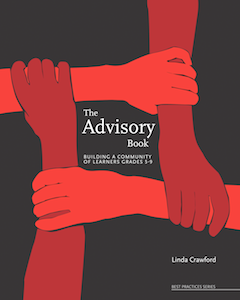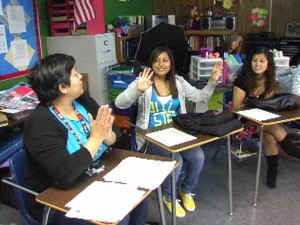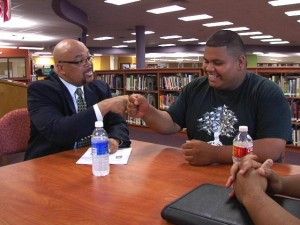Belonging in the Middle Grades
What do a daily classroom greeting, journal entries asking students how they celebrate particular holidays, essays comparing Greek gods to modern celebrities, and a Latin project featuring mushrooms and done in the style of Edward Gorey have in common?
They all relate to ways of fostering student belonging in the middle grades.
In This We Believe: Keys to Educating Young Adolescents, the Association for Middle Level Education proposes that for schools to adequately serve tweens and young teens, they must be developmentally responsive, challenging, empowering, and equitable.
The concept of belonging relates to all four. Here, I’d like to consider what it means for middle graders to belong and for educators to create a sense of “belonging” for every student. I’ll also share some of my research among North Carolina teachers.
It’s all about membership

• frequent inter-personal contacts and interactions, and
• the perception of bonds or relationships that have stability, affective concern, and the likelihood of ongoing interaction. (Baumeister and Leary)
In the words of one of the youth in Elizabeth Moje’s landmark study, belonging encompasses a need “to be part of the story.”
Any person feels the need to belong, and the middle grades are a time when young adolescents are exploring who they are and who they want to be and become. Part of their exploration of their identities involves their need for belonging in a range of groups and settings.
Teachers help create a sense of belonging
Teachers can support students’ belonging in school. One hallmark of the middle school model is Advisory, a program that gives every student an adult advocate. Teachers, acting as advisors, can give each advisee a safe place within the school community.
Many middle schools start the day with Advisory. That time — even if it is only ten minutes — is a great way to ground each student in the school day by sharing a short greeting, giving reminders and announcements, and/or posing a question or topic for brief discussion. The question can be serious or frivolous; it can be school-related, community-related, or a question about life, the universe, and everything. The goal is for students to interact, share their views, and listen respectfully.

In The Advisory Book, (an excellent resource, now in a second edition), Linda Crawford reports on a review of research on Advisory that showed that students in Advisory programs — in comparison to students who did not have Advisory or a parallel school-based program — improved significantly in social-emotional skills and attitudes about themselves, others, and school (two components that relate to student belonging).
See Amanda Wall’s review of The Advisory Book, 2nd Edition
AMLE also has a report of research to support Advisory; while this 2006 brief is a little dated, it is thorough and still pertinent.
Two model Advisory programs
Two programs deserve a special mention when it comes to Advisory.
Developmental Designs for Middle School, created by the non-profit organization Origins, integrates the academic curriculum with a social-emotional curriculum to support young adolescents. Through the DDMS model, schools work to provide for students’ needs for autonomy, competence, relationships, and fun. A focus on any of these areas — especially relationships — can foster a sense of belonging for students.
(Origins is also the Midwestern provider of Responsive Classroom, a compatible model for the elementary grades. Both models involved fee-based workshops and school services.)

You never know what may spur a ritual. Years ago, when my former school implemented student-led conferences, my advisees worked diligently to assemble their portfolios. They had great conversations with their parents and had many keen insights into their learning. After that first round, I congratulated my advisory kids and we all decided to chip in a couple of dollars each and order pizza to eat together at lunch one day. When other advisories learned about our feast, they all wanted to do something similar. Fast forward a couple of years, and the Advisory Lunch has become a school-wide tradition. A ritual! Smaller routines, such as Current Event Monday or a Thursday morning “Modern Family” (or other popular show) recap, are also high-engagement activities.
Without question, Advisory is a great avenue for supporting student belonging. But it’s not the only avenue. Teachers can support student belonging informally through repeated, seemingly small gestures. I have known many teachers who make it a goal of each day to look each student in the eyes and to greet each student by name. With multiple, large classes during the day, teachers may find this a challenging task, but it is rewarding and meaningful for students.
Student ownership of learning
Academic tasks can also support student belonging. Beverly Faircloth has done research about tasks that can “harness” students’ search for belonging and identity development with the academic curriculum. Working with high school students, she found three characteristics of tasks that can support belonging and identity development: (1) the task makes connections with students’ lives and perspectives beyond school; (2) the task blends school requirements with individual perspectives and ideas; (3) the task is grounded in the curriculum.
Middle grades teachers can adapt these guidelines and present academic tasks that allow students to voice their own ideas, opinions, and perspectives while learning. Here are some ways I combined academics and socio-emotional development in my own classroom.
As a teacher of Latin, I often assigned vocabulary poster projects to help students understand the relationships between Latin (or Greek) words and English words. One of the guidelines for this type of assignment was that students incorporate the actual meaning of the words into their poster designs.
My middle schoolers often included aspects of their own personalities and identities into their graphic treatments. A Harry Potter fan who made a poster about English derivatives of the Greek word for “book” designed her poster to look like “The Monster Book of Monsters” (learn more at the Harry Potter Wiki) from Prisoner of Azkaban. A swimmer who did a poster about English derivatives of the Greek and Latin words for “water” chose a blue posterboard, designed it to look like lanes in a pool, and added a couple of her award ribbons. A James Bond aficionada took the conceptual word “skill” and made the poster look like James Bond at a cards table.
And in case you were wondering about the mushroom project mentioned in my introduction: I once assigned seventh graders to do an Alphabet Book-styled project on a category of Latin words. Many students selected animals or items in a house. Two students who were fans of Edward Gorey decided to select various ways that a person could die as their ABC project. They selected male names for each letter of the Latin alphabet and wrote about how each of these men died at the hands of nefarious mushrooms.

The examples above are all summative assessments; daily assignments also can support belonging by allowing students to make connections between school and their own lives and personal interestes. As a teacher of Language Arts, I assigned students a Daily Composition Book. Oftentimes, the topic of the day was for students to relate a specific literary or other idea to their lives or to give an example from their lives of a specific topic from school. In this way, their routine practice of writing helped build the school-to-life connection and, I believe, their feeling that they were in a place where they belonged and had ownership.
My own research
In my recent graduate research, I asked middle school teachers for their thoughts about three domains of motivation: expectancy (Can I do this?), value (Do I want to?), and belonging (Do I belong?). Teachers explained why they thought belonging was important: to help students feel safe, to allow students to be who they are, and to show them that we as teachers care.

Also related to motivation is Kevin Cokley’s research on motivation among African-American college students. In one study of African-American students in Historically Black Colleges and Universities (HBCUs) and Predominantly White Colleges and Universities (PWCUs), Cokley found that encouragement played a great role in students’ motivation. That finding has stayed with me in terms of any student’s need to be encouraged.
When we encourage students, we are telling them, “You can do it. I believe in you. You belong here.” It takes only a moment to give a student a specific comment and to encourage that student. It takes only a little more effort to make that human connection and begin to create a community where we can all belong.
Notes:
• Rafe Esquith’s book Teach Like Your Hair’s on Fire is not about motivation specifically, but it is an excellent and inspiring book for all teachers in terms of motivation and many other ideas. This Scholastic article includes a short interview with Esquith (a fifth grade teacher in inner city Los Angeles) and shares some of his thoughts about building trust in your classroom.
• Another great recent resource is MiddleWeb’s Research Roundup “Insights into Student Motivation,” compiled by co-editor Susan B. Curtis, who gathers together a useful collection of online resources about motivation as a broad topic.
Amanda Wall is an assistant professor in the Department of Teaching and Learning at Georgia Southern University, where she teaches courses in the middle grades program. She taught Language Arts and Latin in grades 5-12 for many years. Her articles for MiddleWeb can be found here.




































